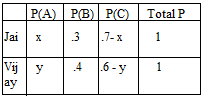For the first question,
P(X>Y) = Probability that the number on the die is greater than the amount won
= 1 - P(number is less than or equal to winning)
Now, P(X>Y) = 1 only if the probability that the number on the die is less than or equal to winning, is zero. But this is not the case(when number on the die is 1, winning is also 1). So this is incorrect.
For the 2nd question, the answer is .6
To derive it, I would suggest this method. Visualize the problem like this :

So what is given is
P(no A, 1 B) = P(J=B,V=B) + P(J=C,V=B) + P(J=B, V=C) = 0.1
Now you need to find
P(no C, 1 B) = P(J=B,V=B) + P(J=A,V=B) + P(J=B,V=A) and you will get this as 0.6